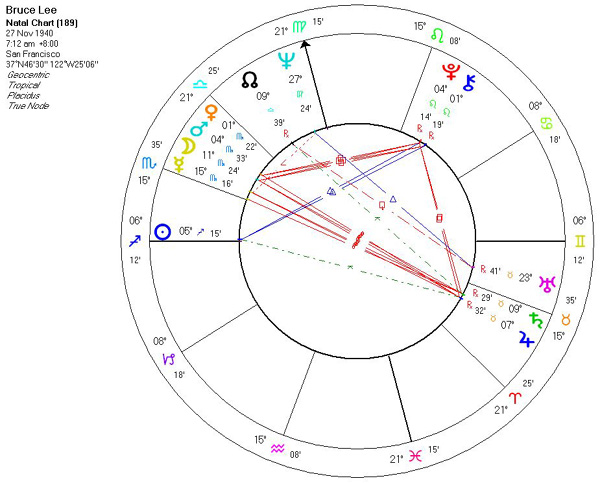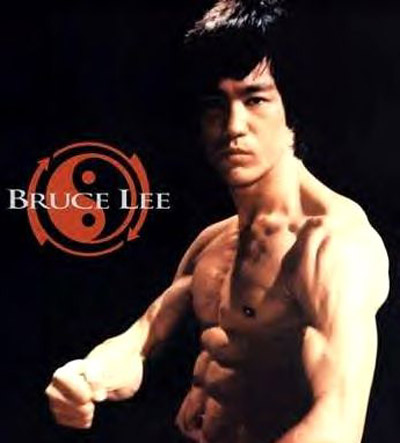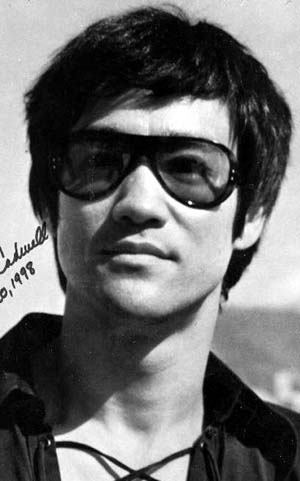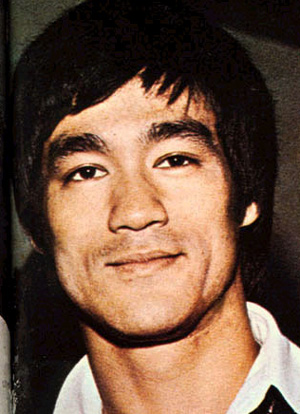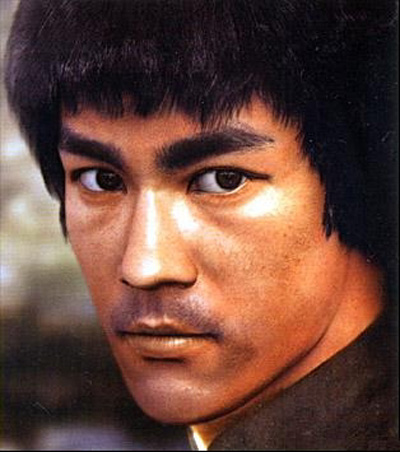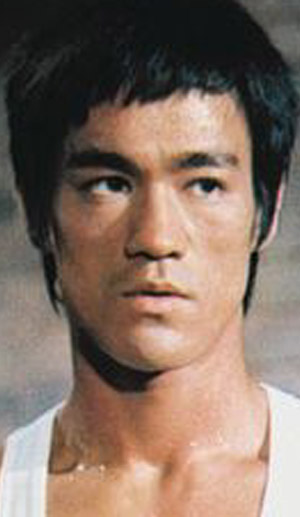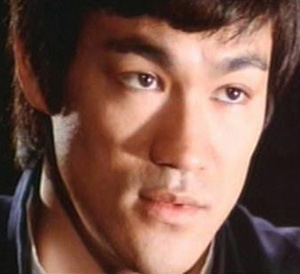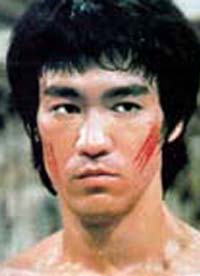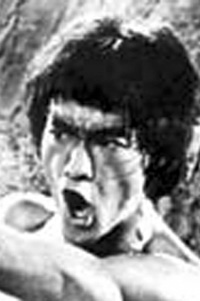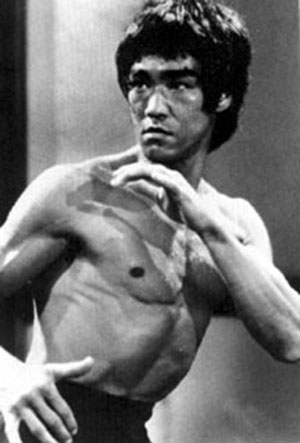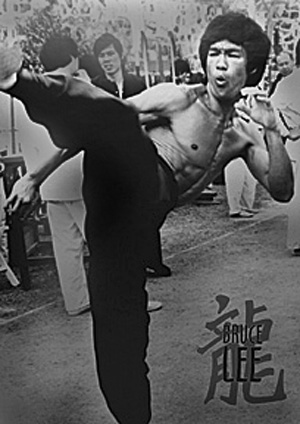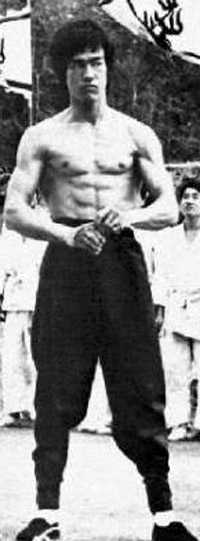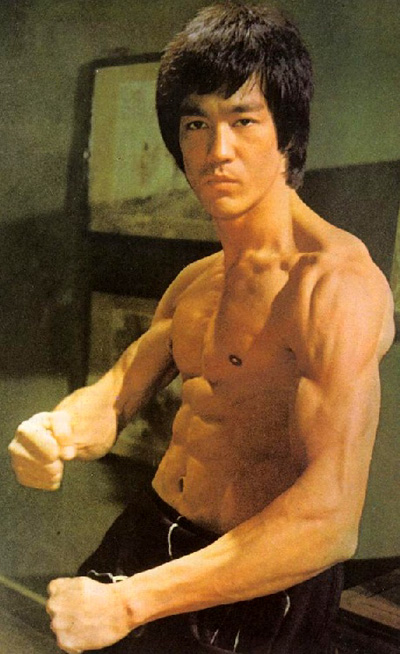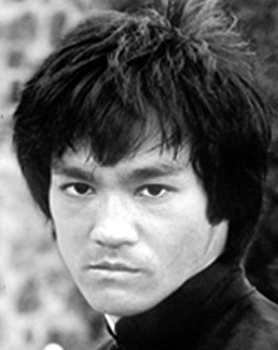Copyright Michael D. Robbins 2005
Astro-Rayological
Interpretation & Charts
s
Biography
Iimages and Physiognomic Interpretations
Circumstances hell! I make circumstances!
(Moon in Scorpio. Sun in Sagittarius conjunct Ascendant trine Pluto.)
Ever since I was a child I have had this instinctive urge for expansion and growth. To me, the function and duty of a quality human being is the sincere and honest development of one's potential.
(Sun conjunct Sagittarius Ascendant)
I'm not in this world to live up to your expectations and you're not in this world to live up to mine.
If you always put limit on everything you do, physical or anything else. It will spread into your work and into your life. There are no limits. There are only plateaus, and you must not stay there, you must go beyond them.
(Neptune conjunct MC. Pluto in Leo in 8th house.)
Love is like a friendship caught on fire. In the beginning a flame, very pretty, often hot and fierce, but still only light and flickering. As love grows older, our hearts mature and our love becomes as coals, deep-burning and unquenchable.
(Venus in Scorpio)
Man, the living creature, the creating individual, is always more important than any established style or system.
Notice that the stiffest tree is most easily cracked, while the bamboo or willow survives by bending with the wind.
Take no thought of who is right or wrong or who is better than. Be not for or against.
The future looks extremely bright indeed, with lots of possibilities ahead - big possibilities. Like the song says, "We've just begun."
The less effort, the faster and more powerful you will be.
You just wait. I'm going to be the biggest Chinese Star in the world.
“All fixed set patterns are incapable of adaptability or pliability. The truth is outside of all fixed patterns.”
“I fear not the man who has practiced 10,000 kicks once, but I fear the man who has practiced one kick 10,000 times.”
“using no way as a way, using no limitations as a limitation.”
“Showing off is the fool's idea of glory.”
“As you think, so shall you become.”
“I am learning to understand rather than immediately judge or to be judged. I cannot blindly follow the crowd and accept their approach. I will not allow myself to indulge in the usual manipulating game of role creation. Fortunately for me, my self-knowledge has transcended that and I have come to understand that life is best to be lived and not to be conceptualized. I am happy because I am growing daily and I am honestly not knowing where the limit lies. To be certain, every day there can be a revelation or a new discovery. I treasure the memory of the past misfortunes. It has added more to my bank of fortitude.”
“If you make an ass out of yourself, there will always be someone to ride you”
“Simplicity is the key to brilliance”
(Sagittarius Ascendant)
“The key to immortality is first living a life worth remembering.”
“"A wise man can learn more from a foolish question than a fool can learn from a wise answer."”
“Forget about winning and losing, forget about pride and pain”
“Always be yourself, express yourself, have faith in yourself, do not you go out and look for a successful personality and duplicate it.”
“Let an opponent graze your skin and you smash into his flesh; let an opponent smash into your flesh and you fracture his bone; let an opponent fracture your bone and you take his life! Do not be concerned with your escaping safely; lay your life before him!”
“Empty your mind, be formless, shapeless - like water. Now you put water into a cup, it becomes the cup, you put water into a bottle, it becomes the bottle, you put it in a teapot, it becomes the teapot. Now water can flow or it can crash. Be water, my friend.”
“A goal is not always meant to be reached, it often serves simply as something to aim at.”
(Sagittarius Ascendant)
“Real living is living for others.”
(Stellium in 11th house)
“Take things as they are. Punch when you have to punch. Kick when you have to kick.”
“As long as I can remember I feel I have had this great creative and spiritual force within me that is greater than faith, greater than ambition, greater than confidence, greater than determination, greater than vision. It is all these combined. My brain becomes magnetized with this dominating force which I hold in my hand.”
“If you spend too much time thinking about a thing, you'll never get it done.”
“Mistakes are always forgivable, if one has the courage to admit them.”
“The possession of anything begins in the mind”
“Man, the living creature, the creating individual, is always more important than any established style or system.”
“If you love life, don't waste time, for time is what life is made up of.”
“A quick temper will make a fool of you soon enough.”
“To hell with circumstances; I create opportunities.”
(Saturn conjunct Jupiter)
“When there is freedom from mechanical conditioning, there is simplicity. The classical man is just a bundle of routine, ideas and tradition. If you follow the classical pattern, you are understanding the routine, the tradition, the shadow - you are not understanding yourself.”
“I am not teaching you anything. I just help you to explore yourself”
“Knowledge will give you power, but character respect.”
“Obey the principles without being bound by them.”
“If you want to learn to swim jump into the water. On dry land no frame of mind is ever going to help you”
“It's not the daily increase but daily decrease. Hack away at the unessential.”
“To me, the extraordinary aspect of martial arts lies in its simplicity. The easy way is also the right way, and martial arts is nothing at all special; the closer to the true way of martial arts, the less wastage of expression there is.”
“"To know oneself is to study oneself in action with another person."”
“Let the spirit out - Discard all thoughts of reward, all hopes of praise and fears of blame, all awareness of one's bodily self. And, finally closing the avenues of sense perception, let the spirit out, as it will.”
“"It's not what you give, it's the way you give it."”
“If you think a thing is impossible, you'll make it impossible.”
“"If you don't want to slip up tomorrow, speak the truth today."”
(Mercury in Scorpio)
“A good martial artist does not become tense but ready. Not thinking yet not dreaming, ready for whatever may come. A martial artist has to take responsibility for himself and face the consequences of his own doing. To have no technique, there is no opponent, because the word 'I' does not exist. When the opponent expands I contract and when he contracts, I expand. And when there is an opportunity, 'I' do not hit, 'It' hits all by itself.”
“The height of cultivation runs to simplicity. Halfway cultivation runs to ornamentation.”
“A fight is not won by one punch or kick. Either learn to endure or hire a bodyguard.”
(Saturn in Taurus)
“You know what I want to think of myself? As a human being. because, I mean I don't want to be like 'As Confucius say,' but under the sky, under the heavens there is but one family. It just so happens that people are different.”
“If you want to do your duty properly, you should do just a little more than that.”
“Knowing is not enough, you must apply; willing is not enough, you must do.”
(Mars in Scorpio)
“The great mistake is to anticipate the outcome of the engagement; you ought not to be thinking of whether it ends in victory or in defeat. Let nature take its course, and your tools will strike at the right moment..”
“What is, is”
“Don't think, Feel, it is like a finger pointing out to the moon, don't concentrate on the finger or you will miss all that heavenly glory.”
“We shall find the answer when we examine the problem, the problem is never apart from the answer, the problem IS the answer, understanding the problem dissolves the problem.”
The void is that which stands right in the middle of 'this' and 'that'. The void is all-inclusive, having no opposite - there is nothing which it excludes or opposses. It is living void, because all forms come out of it and whosoever realizes the void is filled with life and power and the love of all things.”
“If mere mechanical efficiency can make everyone a martial artist, then all is well. Unfortunately, combat, like freedom, is something that can not be preconceived.”
“There will be calmness, tranquility, when one is free from external objects and is not perturbed.”
“Absorb what is useful, Discard what is not, Add what is uniquely your own.”
“Courage is not the absence of fear, it is the ability to act in the presence of fear.”
The following are some of Bruce Lee's s that reflect his fighting philosophy.
"If I tell you I'm good, you would probably think I'm boasting. If I tell you I'm no good, you know I'm lying."
"Be formless... shapeless like water. If you put water into a cup, it becomes the cup. You put water into a bottle; it becomes the bottle. You put it into a teapot; it becomes the teapot. Water can flow, and it can crash. Be water, my friend..."
"Use only that which works, and take it from any place you can find it."
"The more relaxed the muscles are, the more energy can flow through the body. Using muscular tensions to try to 'do' the punch or attempting to use brute force to knock someone over will only work to opposite effect."
"Mere technical knowledge is only the beginning of Kung Fu. To master it, one must enter into the spirit of it."
"There are lots of guys around the world that are lazy. They have big fat guts. They talk about chi power and things they can do, but don't believe it."
"I'm not a master. I'm a student-master, meaning that I have the knowledge of a master and the expertise of a master, but I'm still learning. So I'm a student-master. I don't believe in the word 'master.' I consider the master as such when they close the casket."
"Do not deny the classical approach, simply as a reaction, or you will have created another pattern and trapped yourself there."
"Jeet Kune Do: it's just a name; don't fuss over it. There's no such thing as a style if you understand the roots of combat."
"Unfortunately, now in boxing people are only allowed to punch. In Judo, people are only allowed to throw. I do not despise these kinds of martial arts. What I mean is, we now find rigid forms which create differences among clans, and the world of martial art is shattered as a result."
"I think the high state of martial art, in application, must have no absolute form. And, to tackle pattern A with pattern B may not be absolutely correct."
"True observation begins when one is devoid of set patterns."
"The other weakness is, when clans are formed, the people of a clan will hold their kind of martial art as the only truth and do not dare to reform or improve it. Thus they are confined in their own tiny little world. Their students become machines which imitate martial art forms."
"Some people are tall; some are short. Some are stout; some are slim. There are various different kinds of people. If all of them learn the same martial art form, then who does it fit?"
"Ultimately, martial art means honestly expressing yourself. It is easy for me to put on a show and be cocky so I can show you some really fancy movement. But to express oneself honestly, not lying to oneself, and to express myself honestly enough; that my friend is very hard to do."
"Use no way as way; use no limitation as limitation."
Born November 27, 1940
San Francisco, California
Died July 20, 1973
Hong Kong, China
Height 5'7 1/2" (1.71 m.)
Spouse(s) Linda Lee Cadwell
Bruce Jun Fan Lee (Chinese: ???; pinyin: Li Zhènfán; November 27, 1940 – July 20, 1973) was an American-born Chinese martial artist, instructor, and martial arts actor widely regarded as one of the most influential martial artists of the 20th century, he is considered to be one of the most respected and admired martial artists of all time for his knowledge and understanding of martial arts. Lee's films, especially his performance in the Hollywood-produced Enter the Dragon, elevated the traditional Hong Kong martial arts film to a new level of popularity and acclaim. His pioneering efforts paved the way for future martial artists and martial arts actors such as Jackie Chan, Jet Li, and Chuck Norris.[1]
Bruce Lee's films sparked the first major surge of interest of Chinese martial arts in the West. The direction and tone of his films changed and influenced martial arts and martial arts films in Hong Kong, China, and the rest of the world. Lee became an iconic figure particularly to Chinese; as he portrayed Chinese national pride and Chinese nationalism in his movies.[2]
Many see Lee as a model blueprint for acquiring a strong and efficient body, as well as developing a mastery of martial arts and hand to hand combat skills. Lee began the process of creating his own martial arts fighting system based on philosophy known as Jeet Kune Do. Bruce Lee's evaluation of traditional martial arts doctrines is nowadays seen as the first step into the modern style of mixed martial arts.[3]
Early life was an American Born Chinese (ABC) born at the Chinese Hospital[4] in San Francisco to his Chinese father Lee Hoi-Chuen (???) and Chinese-German[5] mother Grace Lee (???). Bruce's maternal grandfather was German.[6] At the time Bruce was born, his parents were on a tour with an opera company in the United States. At the age of 3 months, he and his parents returned to Hong Kong where he would be raised until the age of 18.
Names
Screenshot from Thunderstorm, one of a few movies Lee Siu Lung starred in as a teenager.Bruce Lee's Cantonese given name, Jun Fan (??; Mandarin Pinyin: Zhènfán), literally means "invigorate San Francisco" (???).[7] At birth, he was given the English name "Bruce" by Dr. Mary Glover. Mrs. Lee had not initially planned on an English name but deemed it appropriate and concurred with Dr. Glover.[8] Interestingly the name "Bruce" was never used within his family until he enrolled in La Salle College, a Hong Kong high school, at 12 years of age, [7] and then again at another high school, St Francis Xavier's College, Kowloon, where he represented their boxing team in inter-school events.
In addition, Lee initially had a birth name Li Yuen Kam[2](???); Mandarin Pinyin: Li Xuànjin) given by his mother, as at the time Lee's father was away on a Chinese opera tour. After several months, when Lee's father returned, the name was abandoned because of a conflict with the name of Lee's grandfather. Lee was then renamed Jun Fan. Finally, Lee was also given a feminine name, Sai Fung (??, literally "small phoenix"), used throughout his early childhood in keeping with a Chinese custom traditionally thought to hide the child from evil spirits.
Bruce Lee's screen name was Lee Siu Lung in Cantonese and Li Xiao Long in Mandarin (???; Cantonese pengyam: Ley5 Siw2 Long4; Mandarin Pinyin: Li Xiaolóng) which literally means "Lee Little Dragon." These were first used by director ??? of the 1950 Cantonese movie ??? in which Lee performed. It is possible that that the name "little dragon" was chosen based on his childhood name "small phoenix". In Chinese tradition, the Chinese dragon and phoenix come in pairs to represent the male and female genders, respectively. However, it is more likely that he was called Little Dragon because he was born in the Year of the Dragon in the Hour of the Dragon, according to the Chinese zodiac.
Education and family
At age 14, Bruce Lee entered La Salle College, a high school, under the wing of Brother Henry. Then, he attended St Francis Xavier's College.
In 1959, Bruce got into a fight with a feared Triad gang member's son. His father became concerned about young Bruce's safety, and as a result, he and his wife decided to send Bruce to the United States to live with an old friend of his father's. All he had was $100 in his pocket and the title of 1958 Crown Colony Cha Cha Champion of Hong Kong. After living in San Francisco, he moved to Seattle to work for Ruby Chow, another friend of his father's. In 1959, Lee completed his high school education in Seattle and received his diploma from Edison Technical School. He enrolled at the University of Washington as a philosophy major. It was at the University of Washington that he met his future wife Linda Emery, whom he would marry in 1964. He had two children with Linda, Brandon Lee (born 1965) and Shannon Lee (born 1969). Brandon, who would also become an actor like his father, died in an accident during the filming of The Crow in 1993.
Martial arts training and development
Young Bruce learned the fundamentals of Wu style Tai Chi Chuan from his father, Lee Hoi Cheun. Lee's Wing Chun Sifu, Yip Man, was also a colleague and friend of Hong Kong Wu family teacher Wu Ta-chi. He always held that the principles of Tai Chi Chuan influenced his view of martial arts all through his life as an actor and a martial artist. While it is obvious that the style studied by his father was the Wu style, Lee was seen on at least one occasion demonstrating the 108 Basic Movements of the Yang form.
Lee started training in Wing Chun at the age of 14 under Hong Kong Wing Chun master Yip Man. Lee was introduced to Yip Man in early 1954 by William Cheung, then a live-in student of Yip Man. Like most martial arts schools at that time, Sifu Yip Man's classes were often taught by the highest ranking students. One of the highest ranking students under Yip Man at the time of Lee's training was Wong Shun-leung, who is understood to have had the largest influence. Yip Man trained Lee privately after some students refused to train with Lee due to his ancestry.[9] Lee would leave before learning the entire Wing Chun curriculum, but Wing Chun formed a base for his later explorations of martial arts.
In between the learning of Tai Chi and Wing Chun, Lee also learned bits and pieces of the Hung Gar style from a friend of his father. There are photographs of Bruce demonstrating animal stances and forms found within its teachings.
Jun Fan Gung Fu
Main article: Jun Fan Gung Fu
Lee began the process of creating his own martial arts system after his arrival in the United States in 1959. Lee called his martial arts Jun Fan Gung Fu (literally Bruce's Gung Fu), which consisted mostly of Wing Chun, with elements of Western Boxing and fencing. Lee taught friends he met in Seattle, starting with Judo practitioner Jesse Glover as his first student and who later became his first assistant instructor. Before moving to California Lee opened his first martial arts school, named the Lee Jun Fan Gung Fu Institute, in Seattle.
In 1964, Lee was challenged by Wong Jack Man, a practitioner of Northern Shaolin. Lee claimed that, after arriving in San Francisco, his theories about martial arts and his teaching of "secret" Chinese martial arts to non-Asian students gave him enemies in the martial arts community. In contrast, Wong stated that he requested a bout with Lee as a result of Lee's open challenge during a demonstration at a Chinatown theater; Lee had claimed to be able to defeat any martial artist in San Francisco, according to Wong.[10] The two fought in December, 1964, at a kung fu school in Oakland, California. Lee and Wong provided significantly different accounts of the private bout[11], which was not filmed. Afterwards, Lee stated in an interview, without naming Wong as the loser, that he had defeated an unnamed challenger. In response, Wong wrote his description of the fight as well as an invitation to Lee for a public match, which was printed on the front page of Chinese Pacific Weekly, a Chinese-language newspaper in San Francisco. Lee did not fight Wong again.
Jeet Kune Do
The Jeet Kune Do Emblem. The Chinese characters around the Taijitu symbol indicate: "Using no way as way" & "Having no limitation as limitation" The arrows represent the endless movement and change of the universe.Main article: Jeet Kune Do
The match with Wong influenced Lee's philosophy on fighting. Lee believed that the fight had lasted too long and that he had failed to live up to his potential. He took the view that traditional martial arts techniques were too rigid and formalistic to be practical in scenarios of chaotic street fighting. Lee decided to develop a system with an emphasis on "practicality, flexibility, speed, and efficiency". He started to use different methods of training such as weight training for strength, running for endurance, stretching for flexibility, and many others which he constantly adapted.
Lee emphasized what he called "the style of no style". This consisted of utilizing a non-formalized approach which Lee claimed was not indicative of traditional styles. Because Lee felt the system he called Jun Fan Gung Fu was too restrictive, it was transformed to what he would come to describe as Jeet Kune Do or the Way of the Intercepting Fist, a term he would later regret because Jeet Kune Do implied specific parameters that styles connotate whereas the whole point of the system was to exist outside of parameters and limitations. Some confuse the Jeet Kune Do system with the personal version that Bruce Lee practiced. Jeet Kune Do can be seen as both a process and a product, the latter deriving from the former.
Bruce Lee certified three instructors: Taky Kimura, James Yimm Lee (no relation to Bruce Lee) and Dan Inosanto. James Yimm Lee, a close friend of Bruce Lee, died without certifying additional students. Taky Kimura, to date, has certified one person in Jun Fan Gung Fu: his son and heir Andy Kimura. Dan Inosanto continues to teach and certify select students. Prior to his death, Lee told his then only two living instructors Inosanto and Kimura (James Yimm Lee had died in 1972.) to dismantle his schools. Both Taky Kimura and Dan Inosanto were allowed to teach small classes thereafter without using the name Jeet Kune Do.
As a result of a lawsuit between the estate of Bruce Lee (also known as Concord Moon) and the Inosanto Academy, the name "Jun Fan Jeet Kune Do" was legally trademarked, and the rights were given solely to the Lee estate. "The name is made up of two parts: 'Jun Fan' (Bruce's given Chinese name) and 'Jeet Kune Do' (the Way of the Intercepting Fist). The development of Bruce Lee's art from 1961 until the end of his life was one smooth and indivisible path. In the beginning, he referred to his teachings simply as Jun Fan Gung Fu.
Some martial arts instructors, in an effort to promote themselves or their martial arts schools, make dubious claims about learning from or teaching Bruce Lee. Yet, only three were certified by Lee.
1964 Long Beach International Karate Championships
's "One inch punch"At the invitation of Ed Parker, Lee appeared in the 1964 Long Beach International Karate Championships [12] and performed repetitions of two-finger pushups (using the thumb and the index finger) with feet at approximately a shoulder-width apart. In the same Long Beach event he also performed the "One inch punch". The description of which is as follows: Lee stood upright, his right foot forward with knees bent slightly, in front of a standing, stationary partner. Lee's right arm was partly extended and his right fist approximately an inch away from the partner's chest. Without retracting his right arm, Lee then forcibly delivered the punch to his partner while largely maintaining his posture, sending the partner backwards and falling into a chair placed behind the partner to prevent injury, though the force of the impact caused his partner to soon after fall onto the floor.
Physical fitness and nutrition
flexing (1972), frontBruce Lee felt that many martial artists of his day did not spend enough time on physical conditioning. Bruce Lee did not resort to traditional bodybuilding techniques to build mass; he was more interested in speed and power. In his book the Tao of Jeet Kune Do, he wrote "Training is one of the most neglected phases of athletics. Too much time is given to the development of skill and too little to the development of the individual for participation." "JKD, ultimately is not a matter of petty techniques but of highly developed spirituality and physique". [13]
The weight training program that Lee used during a stay in Hong Kong in 1965 indicated biceps curls of eighty pounds (36 kgs) and eight repetitions[14] for endurance. This translates to an estimated one repetition maximum of 110 pounds, [15] placing Lee in approximately the 100th percentile for the 121 to 140 pound weight class.[16]
Lee believed that the abdominal muscles were one of the most important muscle groups for a martial artist, since virtually every movement requires some degree of abdominal work. Perhaps more importantly, the "abs" are like a shell, protecting the ribs and vital organs. Bruce Lee's washboard abs did not come from mere abdominal training; he was also a proponent of cardiovascular conditioning and would regularly run, jump rope, and ride a stationary bicycle. A typical exercise for Lee would be to run a distance of two to six miles in fifteen to forty-five minutes.
Nutrition
Another element in Lee's quest for abdominal definition was nutrition. According to Linda Lee, soon after he moved to the United States, Bruce Lee started to take nutrition seriously and developed an interest in health foods and high-protein drinks. "Several times a day, he took a high-protein drink made up of powdered milk, ice water, eggs, eggshells, bananas, vegetable oil, peanut flour and chocolate ice cream," and she claims Bruce's waist fluctuated between 26 and 28 inches. "He also drank his own juice concoctions made from vegetables and fruits apples, celery, carrots and so on, prepared in an electric blender."
Bruce Lee ate lean meat sparingly and consumed large amounts of fruits and vegetables. In later years, he became very knowledgeable about vitamin supplements, and each day apportioned himself exactly the right quota of vitamins A, B, C, D, and E.
Bruce Lee's feats
's two finger one-handed push upsBruce Lee's striking speed from 3 feet away was five hundredths of a second. (Glover[17])
Bruce did one-hand push ups using only 2 fingers[18].
Bruce was able to break a 150lb bag with a sidekick. (Coburn[17])
Bruce would ride the equivalent of 10 miles in 45 minutes on a stationary bike, sweating profusely afterwards. (Uhera [17])
Bruce's last movie Enter the Dragon was made for US$850,000 in 1973 ($3.74 million in 2005 currency. BLS[18]). To date, Enter the Dragon has grossed over $90,000,000. (IMDB.com[19])
Bruce was able to hold a 125-pound barbell at arms length in front of him (with elbows locked) for several seconds. (Little[20]
In 2004, UFC president Dana White credited Bruce Lee as the "father of mixed martial arts"[21].
In September 2004, a BBC story stated that the Herzegovinian city of Mostar was to honor Lee with a statue on the Spanish Square, as a symbol of solidarity. After many years of war and religious splits, Lee's figure is to commend his work: to successfully bridge culture gaps in the world. The statue, placed in the city park, was unveiled on November 26, 2005 (One day before the unveiling of the statue in Hong Kong, below).[22]
In 2005, Lee was remembered in Hong Kong with a bronze statue to mark his sixty-fifth birthday. The bronze statue, unveiled on November 27, 2005, honored Lee as Chinese film's bright star of the century.[23]
Martial arts lineage
Lineage in Wing Chun / Jeet Kune Do
Sifu in Wing Chun Yip Man (??)
Other instructors Sihing Wong Shun-leung (???)
Notable Sparring partner Toe Dai Hawkins Cheung Note: He was Bruce Lee's friend at the time.
Creator of Jeet Kune Do
Known students in Jun Fan
Gung Fu/Jeet Kune Do Jesse Glover
Steve Golden
Dan Inosanto
Taky Kimura
Jerry Poteet
Ted Wong
James Yimm Lee
Numerous others...
Famous students taught
Jun Fan/Jeet Kune Do Kareem Abdul-Jabbar
James Coburn
Joe Lewis
Roman Polanski
Lee Marvin
Steve McQueen
Chuck Norris
Numerous others...
Death by "misadventure"'s death was officially attributed to cerebral edema.
On July 20, 1973, Lee was in Hong Kong, due to have dinner with former James Bond star George Lazenby, with whom he intended to make a film. According to Lee's wife Linda, Lee met producer Raymond Chow at 2 P.M. at home to discuss the making of the movie Game of Death. They worked until 4 P.M. and then drove together to the home of Lee's mistress Betty Ting Pei, a Taiwanese actress who was to have a leading role in the film. The three went over the script at her home, and then Chow left to attend a dinner meeting.
A short time later, Lee complained of a headache, and Ting Pei gave him an analgesic. At around 7:30 P.M., he laid down for a nap. After Lee did not turn up for the dinner, Chow came to the apartment but could not wake Lee up. A doctor was summoned, who spent ten minutes attempting to revive him before sending him by ambulance to Queen Elizabeth Hospital. However, Lee was dead by the time he reached the hospital. There was no visible external injury; however, his brain had swollen considerably, from 1,400 to 1,575 grams (13%). Lee was thirty-two years old. On October 15, 2005, Chow stated in an interview that Lee was allergic to Equagesic. When the doctors announced Bruce Lee's death officially, it was coined as "Death by Misadventure."
However, the exact details of Lee's death are controversial. Bruce Lee's iconic status and unusual death at a young age led many people to develop many theories about Lee's death. Such theories about his death included murder involving the triads, a curse on Lee and his family, etc. The theory of the curse carried over to Lee's son Brandon Lee, also an actor, who died nearly 20 years after his father in a bizarre accident while filming The Crow.
The grave site of Bruce Lee and his son, BrandonUpon his death his wife, Linda, returned to her home town of Seattle and had Bruce buried at lot 276 of Lakeview Cemetery. His son Brandon is buried beside him. Pallbearers at his funeral on July 31, 1973 included Steve McQueen, James Coburn, Danny Inosanto, Taky Kimura, Peter Chin, and his brother, Robert Lee. To this day, over 30 years after his death, fresh flowers are found on his gravestone every day.
Books authored's Fighting Method 1-5
Chinese Gung-Fu: The Philosophical Art of Self Defense
The Tao of Jeet Kune Do
Acting career
Lee's father was a famous opera star. Through his father he was introduced into films at a very young age and appeared in several black-and-white films as a child.
In the 1960s Lee attempted to start his acting career in America. Lee became famous for playing Kato in the TV series The Green Hornet which lasted for only one season.
In 1967 he played a martial arts instructor in an episode of the television series Ironside. In 1969 he appeared in the film Marlowe where he played a thug who smashed up James Garner's office with karate chops and kicks. In 1971 he appeared in four episodes of the TV series Longstreet playing a martial arts instructor to James Franciscus.
Not happy with the roles that he was being offered in America, Lee then returned to Hong Kong and was offered a film contract by Raymond Chow for his production company Golden Harvest. He starred in three films which shot him to stardom all over Asia, The Big Boss (1971), Fist of Fury (1972) and Way of the Dragon (1972) which he also wrote and directed. and Chuck Norris in Way of the DragonIn 1964 at a demonstration in Long Beach, California, Lee met Karate champion Chuck Norris. In Way of the Dragon Lee introduced Chuck Norris as his opponent in the famous final fight scene at the colloseum in Rome.
His last completed film Enter the Dragon (1973) was the first to be produced jointly by a Chinese and American studio and released two weeks after his untimely death cementing his status as a martial arts legend.
Kareem Abdul-Jabbar, a student of Bruce Lee, co-starred in Game of Death, Lee's incomplete film which he also directed. In the film, Lee, wearing the now famous yellow track suit, took on the 7 foot 2 giant basketball player in a climatic fight scene. Unfortunately, Lee died before the film was finished. Lee had shot over 40 minutes of footage for Game of Death prior to starting shooting for Enter the Dragon. After his death, Robert Clouse who directed Enter the Dragon finished the film using a Bruce Lee look-alike and footage of Lee from his other films and released it in 1978.
Filmography
Lee starred in a leading role in five feature films, two of which (Enter the Dragon and Game of Death) premiered after his death.
Released Chinese and English title of original release U.S. title Note
1941 Golden Gate Girl Plays an infant
1946 The Birth of Mankind
1948 Fu gui fu yun, aka Wealth is Like a Dream
1949 Meng li xi shi, aka Sai See in the Dream Plays "Yam Lee"
1950 Xi lu xiang, aka The Kid My Son, Ah Chung Plays "Lee Siu Lung"
1951 Ren zhi cue aka Infancy Plays "Ngau".
1953 Qian wan ren jia
1953 Fu zhi guo aka Blame it on Father Father's Fault
1953 Ku hai ming deng aka The Guiding Light
1953 Ci mu lei aka A Mother's Tears
1953 Wei lou chun xiao aka In the Face of Demolition
1955 Gu xing xue lei
1955 Gu er xing
1955 Ai aka Love
1955 Ai xia ji aka Love Part 2
1955 Er nu zhai aka We Owe It to Our Children
1956 Zhia dian na fu
1957 Lei yu aka The Thunderstorm
1960 Ren hai gu hong aka The Orphan Plays "Ah San".
1969 Marlowe same Plays "Winslow Wong".
1971 The Big Boss Fists of Fury Plays "Cheng Chao-an". Fights against a drug lord in Thailand.
1972 Fist of Fury The Chinese Connection Plays "Chen Zhen" ??. Fights against Japanese tyrants to avenge his master in Shanghai.
1972 Way of the Dragon Return of the Dragon Plays "Tang Long". Fights crime in Rome, Italy. Released after 'Enter the Dragon' in the U.S.; hence the title.
1973 Enter the Dragon same Plays Shaolin martial arts master "Mr. Lee". Sent as a spy into a tournament, hosted by a rogue-monk-turned-drug-lord.
1978 Game of Death same Plays "Billy Lo". Lee acts only in the last third of the movie, due to it being pieced together after his death.
Note: The title The Chinese Connection (a play on the then-recently-released The French Connection) was originally intended for The Big Boss due to the drugs theme of the story.
and Jackie ChanYuen Lo, known later as Jackie Chan, was a member of the Seven Little Fortunes. He also was a stunt double for the villain Mr. Suzuki in Lee's Fist of Fury. In the film Enter the Dragon, Chan was one of the henchmen disposed of in the underground lair.
Yuen Wah, also a member of the Seven Little Fortunes, and later to become a well known actor in his own right (notably starring in 2005's Kung Fu Hustle), was Lee's stunt double in Lee's last few films.
Television Appearances
The Green Hornet (1966-1967) .... Kato
Batman (1966) .... Kato
Ironside (1967) .... Leon Soo
Here Come the Brides (1969) .... Lin
Longstreet (1971) .... Li Tsung Philosophy
Bruce Lee and Kareem Abdul-Jabbar in Game of Death.Although Bruce Lee is best known as a martial artist and actor, Lee majored in philosophy at the University of Washington. Lee's books on martial arts and fighting philosophy are well-known both for their philosophical assertions both inside and outside of martial arts circles. His philosophy often mirrored his fighting beliefs, though he was quick to claim that his martial arts were solely a metaphor for such teachings. His influences include Taoism and Buddhism.
Please note to serious martial arts that Bruce Lee was a contemporary of the Hindu Philosopher teacher Jiddu Krishnamurti. His entire philosophical approach is based on Krishnamurti's teachings. You will note in the book The Tao Of Jeet Kune Do that Lee recommends reading Krishnamurti.
NAME Lee, Bruce
ALTERNATIVE NAMES
SHORT DESCRIPTION Martial artist
DATE OF BIRTH November 27, 1940
PLACE OF BIRTH San Francisco, United States
DATE OF DEATH July 20, 1973
PLACE OF DEATH Hong Kong
According to the Chinese calendar, 1940 was the Year of the Dragon. A Cantonese film actor named Lee Hoi Chun was performing in San Francisco accompanied by his pregnant wife Grace. By November, Grace had gone into labour and was taken to hospital, but her husband continued on to New York to perform there. On the 27th of November, 1940, at the Jackson Street hospital, Grace gave birth to a baby boy. He was named Lee Jun Fan, which meant "To Return Again". The child would return to his place of birth someday. The doctor attending the arrival gave the child the English name Bruce... And the legend was born !!
At the age of 6, Bruce started to appear in numerous Chinese films. His first film was called "A beginning of a boy." As he made more films it was decided that he should star in a film with his father. The film was called "My Son Ah Cheun". Bruce had a bigger role than his father. In each film he played a problem child, always stealing and fighting. He made at least 20 of these Cantonese films including "Black Boy Jungle" and "Boys on the Street".
When Bruce was 14, he got beaten up in a street fight. So, after discussing the matter with his mother he decided to learn martial arts and develop his physique and self defense abilities.
Most people think that Bruce was born muscular. It was actually totally the opposite; he was always rather frail as a child and never ate well even when he returned to the U.S in 1958. Only through constant training and proper eating did he build himself up into the super-human physical specimen that he was to become. Bruce was never to lose a single fight ever again!!
Although his father had him wielding a sword at 6, his first REAL teacher was the Wing Chun master, Sifu Yip Man. Bruce became obsessed with the whole concept of Wing Chun and soon became very good. One of the Wing Chun training methods was the wooden dummy - A training device which builds both speed and focus. Another one of his teachers was Siu Hon Sung, a kung fu expert. Bruce had been learning Cha Cha dancing and offered to trade his knowledge of it for some of his kung fu lessons. It would normally take 3 weeks to learn 30 kung fu moves, but Bruce mastered them in only 3 nights. Siu Hon Sung never did learn any Cha Cha!
In 1958 Bruce became the Hong Kong Cha Cha champion. He then made 2 more Cantonese films, "The Orphan" and "Thunderstorm". Thunderstorm is the only film where he didn't have a single fight, although there are certain confrontations.
Bruce, fighting Dan Inosanto in "Game of Death".
As time passed, Bruce would fight in the streets trying to see just how good he was. Eventually the police warned his mother Grace, that if it didn`t stop, Bruce would be Arrested. So in April 1958, his father gave him $100 US and sent him to San Francisco (his place of birth) with the hope that Bruce would change and become more responsible.
He boarded a boat and left. He made a little more money on the way there giving Cha Cha lessons to his fellow passengers.
In San Francisco Bruce lived with his fathers friend, Ruby Chow, who owned a restaurant. Bruce worked in the restaurant while living in the attic.
After he finished High School, he was still constantly training and developing his skill in the martial arts. For Bruce it wasn't enough to be just a good martial artist, he had to be the BEST.
Bruce grew tired of the restaurant and headed for Seattle to study Philosophy at the University of Washington.
In 1959, he met a fellow Asian called Taki Kimura. He was twice Bruce's age and had suffered many years of racial abuse. Bruce persuaded him to take pride in his Asian identity and taught him martial arts. Another student was Roy Hollingsworth. Eventually they suggested that he open a school to make money.
In Hong Kong, kung fu was a secret Chinese weapon and was never taught to any non-Chinese person, but Bruce welcomed ANYONE who was interested in learning what he had to teach. In his opinion the Chinese people were not the only worthy persons to learn this great art, and so he broke the racial barriers that had been forged over time!!
In 1961 while teaching some fellow university students Bruce met a young girl called Linda Emery. They soon fell in love and got married... Later, their son Brandon was born, followed a couple of years later by Shannon.
In 1963, Bruce wrote a book called "Chinese Kung Fu". It was incredibly detailed with precise drawings.
In 1964, at a Karate tournament hosted by Ed Parker, Bruce demonstrated his abilities to a large audience... At Long Beach, with Taki Kimura as his assistant, he showed off his 2 finger press ups and his legendary one inch punch.
A noted television producer who was really impressed by Bruce's intensity and focus approached him and a screen test was arranged. This lead to his playing the role of Kato in the Green Hornet series which was filmed in 1965.
While filming this series, Bruce left Taki Kimura in charge of his kung fu school. Although the Green Hornet never really took off, it lasted for 30 half hour episodes. Bruce, surprisingly, as Kato became more popular than the main star, especially in Hong Kong.
In the documentary "Bruce Lee: The Martial Arts Master" Van Williams who was the main star of the Green Hornet recalls how Bruce used to run around the set practicing his kicks. "He would jump up and tap you on the ear with his foot, but this stopped when one of the extras turned around and got his jaw dislocated". During filming Bruce liked to work in close to improve the fight scenes, but he also injured quite a few stuntmen by doing this. The producers found it pretty hard to find stuntmen in the end. Bruce had to slow his movements down because on film, he was practically a blur and you couldn't see what he was doing properly!!
After the Green Hornet, Bruce opened up another kung fu school called "Lee Jun Fan, Gung fu institute". This is where he learned to use the nunchaku`s from fellow student Danny Inosanto. Here he taught actors like James Coburn, Steve McQueen and Kareem Abdul-Jabbar. He had now become so popular that he could charge up to $300 US an hour for instruction.
This was also the place where he created his own technique of Jeet Kune Do, which means (The Way of the Intercepting Fist). He thought it would be better to intercept and attack, rather than blocking and then attacking.
Bruce believed intercepting an attack would be a lot faster than blocking and then attacking as the latter was comprised of two separate movements.
In 1967, Bruce starred in "A Man Called Ironside", as a martial arts instructor, Bruce always did his own stunts as well. He then filmed 12 episodes of "Longstreet", a short series where he teaches a guy his new Jeet Kune Do technique. This was a great idea that would let Bruce show the world his new technique.
He became more and more interested in making a Hollywood movie and wanted to make more money than Steve McQueen per film... This Bruce eventually did achieve!!
In 1970, Bruce realized after the advice of one of his students (James Coburn), that his immediate film career was to be in Hong Kong.
When appearing on a TV show, he broke 4 out of 5 one inch thick boards, and one dangling piece as well (Breaking a dangling one inch piece of wood is an amazing feat).
This was seen by TV producer Raymond Chow who had just opened up Golden Harvest studios. He offered Bruce a two picture deal and they flew off to Thailand to film "The Big Boss". During filming, one of the Thais thought that the fight co-ordinator was faster than Bruce, 5 minutes later... he changed his mind!!!
Another thing that surprised the cast was Bruce opening a bottle of drink with one thumb (The kind that normally needs a can opener). The movie became a smash hit, breaking all known box office records. He then flew to Shanghai and filmed "Fist of Fury". Raymond Chow told Bruce that he would play a bigger part in producing it than in his last film. This once again broke all the box office records, including the ones from "The Big Boss".
By now Bruce had become a national hero and started up his own company called "Concord Productions" and decided that he would write, direct and star in his next film. He went to Europe location hunting, finally deciding on Rome. He brought in 3 top martial artists, Bob Wall, Whong In Sik and Chuck Norris, who he would fight at the end of the film. The result was another sellout; police had to arrive to halt the traffic jams and big crowds.
All 3 of these films had Bruce arriving in a strange town, not knowing his potential enemies. In "The Big Boss", he was in Thailand working at an ice factory with his cousins. In "Fist of Fury", he had come to Shanghai to attend his teacher's funeral, finding his school abused and insulted by the local Japanese school. In "Way of the Dragon" he comes to Rome to help out at a friend's restaurant, which is being hassled by a protection racket. Also the enemies were never Chinese, always foreigners like the Thais, Japanese, Europeans and Americans. Even when there was the odd bad Chinese guy, it's clearly pointed out that they're just misguided pawns of a foreign boss.
Bruce would often be challenged by the extras, but he was never actually defeated, apart from the time when he was 14. Bruce didn't drink, so the characters he played didn't drink either. He always showed himself like he was in real life. "The Way of the Dragon" is the best example of Bruce in real life. In the only bedroom scene he ever filmed in "The Big Boss", a prostitute gets him drunk and takes him back to her place, only to watch him then fall asleep. He would also show off his ability to play all kinds of different characters. In "Fist of Fury" he dresses up as an old newspaper guy as well as a telephone repair man.
Bruce, James Coburn and Stirling Silliphant had been trying to put together a project to be called "Silent Flute". 20th Century Fox agreed to do it, but on a tiny budget and providing that it could be shot in India. They spent weeks location hunting there and finally decided it was a waste of time. In Nepal Bruce saw a Bigota (Tall Tower). This gave him the idea for "Game of Death". Bruce only filmed 1/3 of this film before being interrupted to film the eventual Hollywood smash hit "Enter the Dragon".
"Game of Death" was completed in 1978 after Bruce`s death. The story line is changed and Bruce only appears for 10 minutes at the end. This is footage from the Tower version, which he had intended. The first 95% of the film is NOT the missing scenes!!
"Enter the Dragon" was the 1st time a U.S and Hong Kong film company had come together to make a film. This was the film that brought Bruce world wide fame and made him the world`s first Asian superstar. The big fight scene at the end took 7 days to film, it was during this that an extra challenged Bruce in real life. He wanted to experience Bruce`s Jeet Kune Do. Bruce drew a circle on the floor and told him that he had 3 punches to knock him out of it. The extra couldn`t do it, so Bruce told him, "OK my turn". He pointed to his shoulder blade and said "I`m going to hit you right here, are you ready?" The guy said "What do you mean, am I ready?" Before he could say anything, his teeth started falling out of his mouth. Bruce was just SO fast. Another extra challenged him. They sparred for a bit, then the guy got kicked in the head...and that was enough.
The mirror scene took hours to set up, getting the mirrors in the perfect place, so they didn't reflect any cameras. People would argue over whose job it was to do stuff; this is where Bruce came in... The Chinese would die for him. Eventually the film was completed.
During the time of filming "Game of Death", Bruce had been working with some new character ideas. They would have wielded weapons, like swords and long knives. On the documentary "The Legend" you can see photos of at least 4 of these characters. One of them is a blind swordsman, his version of a character called Zatawichi. (A popular Japanese film at that time). Unforunately we`ll never see Bruce in these roles, but it is interesting to think about the kind of sword films Bruce could have produced.
On the 10th May 1973, the trouble for Bruce Lee had begun. While dubbing the sound effects for "Enter the Dragon", he passed out for a whole half an hour. He went to the hospital, and was prescribed the drug Manatol. It was used to reduce an apparent brain swelling.
On July 20th 1973, Bruce had arranged to meet Raymond Chow along with actress Betty Ting Pei who would star in "Game of Death". He stopped off at Betty`s house and told her that he had a headache. She gave him an Aquagesic (a painkiller that she regularly used ). Bruce laid down in her bed and went to sleep. During his sleep, the brain swelling returned and triggered an allergy to the painkiller called a cerebral edema.
Later Betty tried to wake him but couldn't. Panicking, she called Raymond Chow, who came over and called the doctor. Bruce was rushed to the Queen Elizabeth hospital, barely alive. The ambulance crew was fighting to resuscitate him, but Bruce was pronounced "dead on arrival".
As the news spread across the world, people talked about nothing else, refusing to believe it. Bruce had two funerals, one in Hong Kong and one in the U.S. Over 27,000 people attended his funeral, few could hide their grief. People were just breaking down and crying when they saw him in the open coffin. A banner was placed amongst the many tributes reading "A star sinks in a Sea of Art".
When the press found out that Bruce had died at Betty`s house, they were quick to speculate that Bruce had died while they were having sex. To this day vicious rumours are still spread across the world. At the airport, Linda broke her silence and told Hong Kong to drop it and that she blamed nobody, and that Bruce had died of natural causes.
His funeral in Seattle was attended by all his friends, family and former students. James Coburn and Steve McQueen acted as pallbearers. Should you wish to watch the funeral, you can find it on the documentary (Bruce Lee: The Man and the Legend). Finally on July 31st, 1973, Bruce was laid to rest in Seattle at the Lake View Cemetary.
His and Brandon's graves are regularly visited by people from all over the world. There are ALWAYS fresh flowers on their graves each day. Some day, I too will place mine there and pay my respect to my favourite person in the whole world.
Soon after the funeral, as the wild rumours continued, the autopsy results were that Bruce had died of a cerebral adema in reaction to the painkiller that he had taken... The result was death by misadventure.
For years Betty Ting Pei had kept quiet, ignoring the insults thrown at her until in 1983 when she first broke her silence on a TV show and told the world that she would never have done anything to hurt Bruce as he was a very good friend. But the rumours are STILL going on. Some I've heard are that a Chinese mafia gang arranged his death, who supposedly had control over all of the Chinese actors. Another says that he'd been killed by Shaolin monks for teaching the secrets to the outsiders.
Another rumour is the curse. Bruce supposedly was haunted by personal demons. He had premonitions that he would die at half his father's age of 64 (which he did at 32). Also a protector of evil blew off his roof to warn away evil spirits. The same thing happened to the previous occupants of his house and disaster had befallen them. Kareem Abdul-Jabbar's basketball number was 33, Bruce would have been 33 that year in November... The rumours just go on. Personaly I believe in the cerebral edema; the swelling was brought on by great stress over work, Bruce practically wore himself out to a disappointingly early grave.
In 1978, the producers of "Enter the Dragon" decided to finish "Game of Death" as a tribute to him. In my opinion, they'd have been better off to show us the entire 30 minutes of the REAL version. The first 95% is not the MISSING scenes but a crappy changed storyline.
To this day many Bruce Lee Imitators have tried to be just like him, but have all just faded. Maybe a star like Jackie Chan can rise to the limits, but even Jackie Chan doesn`t claim to be the new Bruce Lee. There will never be a NEW Bruce Lee.
This is Bruce Lee...... The Legend !!!
